This story is part of a series Oregon Public Broadcasting is doing on how well the Northwest is prepared for the magnitude 9.0 earthquake that scientists say will hit along the Cascadia Subduction Zone just off the Pacific Coast.
In this piece we look at:
- A hospital that endured a 9.0 quake without a single window breaking
- The engineering that made that possible
- The differences between Oregon standards and those in Japan
- Why is Oregon so unprepared for a 9.0 quake?
Three times in three years Jay Wilson has returned to Kadonowaki, Japan. Each time, the weeds are a little bit taller, the concrete foundations are a little more weathered.
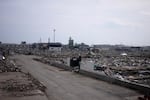
The scene near Kadonowaki shortly after the 2011 tsunami.
Stephanie Chang
On March 11, 2011, a tsunami scraped a vast swath of this town from the earth. Homes and businesses were reduced to rubble. A rebuilt paper mill is among the few structures resurrected here after the disaster.
As Wilson surveys the landscape, it's hard to know whether he's more rattled by this tsunami that has happened, or the tsunami that will happen -- in Oregon.
“It’s a kind of foreshadowing of what some communities are going to look like when this thing does happen someday," said Wilson, chairman of the Oregon Seismic Safety Policy Advisory Commission. "You know there are going to be some locations where you can’t go back.”
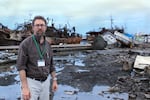
Jay Wilson, Oregon Seismic Commission Chair, surveys tsunami damage on a 2011 visit to Japan.
Jay Wilson
Wilson climbs into a van carrying Chris Goldfinger, a paleo-seismologist with Oregon State University, and Allison Pyrch, a geotechnical engineer with the Seattle-based engineering firm, Hart Crowser. Trips like this help them imagine what Oregon will look like after a magnitude 9.0 subduction zone earthquake.
All agree that the science points to a one-two earthquake-and-tsunami combo in Oregon that will be every bit as powerful as the one that struck Japan. Estimates based in part on Goldfinger's research indicate there is a 37 percent chance of this happening on the Oregon coast sometime in the next 50 years.
“This is not a fantastical theory of the future,” Goldfinger said. “This is going to happen in these (Oregon coast) towns soon.”
The Oregon delegation doesn’t linger amid the ruins of Kadonowaki. They’ve come to Japan to see what worked. And what worked lies on a hill just a few miles up the road from here.
The Hospital That Withstood A 9.0
Vans deliver a stream of patients to the front door of the Ishinomaki Red Cross Hospital. The five-story, 402 bed hospital functions today just as it did before, during, and immediately after the 2011 earthquake and tsunami.
The massive building rises like a beacon on a short incline in Ishinomaki City several miles from Kadonowaki. It was constructed in 2006 to replace a hospital that used to be located along the waterfront. Experts concluded that the old hospital was vulnerable to a tsunami, so they closed it.
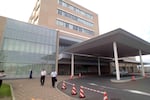
Not a single window broke in the Ishinomaki Red Cross Hospital during Japan's Magnitude 9 earthquake on March 11, 2011.
Jay Wilson
When the 2011 tsunami struck, a wall of water and debris destroyed nearly 46 percent of Ishinomaki City. The old hospital, which had been converted to a nursing school, was inundated to the ceiling of the first floor.
Dr. Iwao Kaneda works at the new hospital. He's busy today, with a lobby full of patients. Many are still undergoing treatment for lingering psychological trauma from the earthquake that killed more than 3,000 in the Ishinomaki area alone.
Dr. Kaneda makes it clear to Wilson that he only has time to talk for the 30 minutes he's allotted in his schedule. But the doctor -- who was on duty at the hospital on the day of the earthquake -- is eager to tell Wilson a success story from the tragedy.
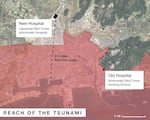
Ishinomaki Red Cross Hospital was out of reach of the 2011 tsunami and withstood the 9.0 earthquake while Ishinomaki City's old hospital flooded to the first floor.
Jason Bernert / OPB
On March 11, 2011 the hospital shook hard for about three minutes. Video from that day shows staff bracing against desks as doors swing back and forth and windows rattle uneasily.
But when the shaking stopped, doctors and nurses walked to a well-lit conference room to implement their emergency plan.
“No staff were hurt and none of the important medical equipment was damaged,” said Dr. Kaneda. No broken windows. No collapsed ceilings. No flooding from the tsunami that stopped miles from the hospital’s doors.
Engineering Is The Key
The hospital wasn’t wrapped in a magic bubble — its emergency water supply proved inadequate and its emergency generators provided only half the electricity staffers were accustomed to. But within an hour, the intact building was accepting patients and acting as a refuge for throngs of survivors who’d lost everything.
The Ishinomaki Red Cross hospital treated nearly 4,000 patients within the first seven days after the disaster. Normally, the hospital treats about 60 patients a day.
“If you are expecting the same kind of tsunami disaster we experienced, you have to build medical facilities in the areas the tsunami can’t reach,” Dr. Kaneda said.
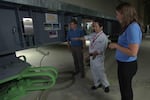
Hiraku Abe, an engineer with Ishinomaki Red Cross, explains the base-isolation “springs” beneath the hospital.
Todd Sonflieth / OPB
He added that the building was engineered with large earthquakes in mind, then asked, “Have you seen our basement?”
Hiraku Abe, an engineer with Ishinomaki Red Cross, leads Pyrch, Wilson and Goldfinger down the stairs to the basement. It surrounds the building like a moat. The building floats above the basement on spring-like structures, made of rubber and steel. It's as if the building is balancing on over a hundred massive pogo sticks.
Prych, the engineer from Oregon, gasps. “This is geotechnical engineering…" Pyrch hesitates before going for the word, "Porn!”
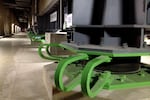
Base Isolation support.
Allison Pyrch / DOGAMI
It’s a feat of engineering called base isolation. After a series of technical exchanges with Abe, Prych explains that the system provides shock absorbers that cushion the five-story hospital above.
“The ground motions actually don’t reach the structure. The building has a much calmer movement," Pyrch said. Pyrch is captivated by the design. This is not the way hospitals are built in Oregon.
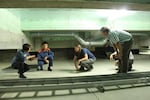
Allison Pyrch and Chris Goldfinger examine seismic engineering of a fire station in Tome, Japan.
Ed Jahn / OPB
Next, Abe shows Pyrch a large metal stylus suspended from the ceiling that reaches down to a metal plate bolted to the basement floor. On March 11, 2011, the stylus skipped and bounced, marking the plate like an Etch-A-Sketch.
"It bounced horizontally 26 centimeters and the other side also moved about the same distance," Abe said.
The stylus rendered in graphic form the ease with which the hospital weathered a 9.0 earthquake that ripped apart the surrounding countryside. The hospital rocked and rolled, then settled back into place. Engineers estimate the hospital can sustain several more earthquakes of equal magnitude without needing to replace the base isolation "springs."
Oregon's Earthquake Standards Far Weaker Than Japan's
Pyrch, a member of an American Society of Civil Engineers group (ASCE) that examines seismic engineering throughout the world, says there’s nothing like the Ishinomaki Red Cross hospital in Oregon.
That's because current state seismic standards only require new buildings to be safe enough for occupants to escape after an earthquake.
Japan’s long history with earthquakes has created a different culture. “They design to make sure that the infrastructure is useable afterwards” Pyrch said.
In Oregon, even so-called seismically engineered buildings may have to be torn down if they sustain even one earthquake as large as the one that shook Ishinomaki.
“When I drive through Japan and I see all the bridges and overpasses I’m like, ‘Wow, base isolation! Base isolation!' " Pyrch said. "I see something that’s up and running and standing. And that’s not the case when you drive through Oregon.”
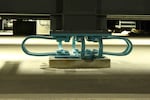
Base isolation support beneath the Ishinomaki Red Cross hospital.
Allison Pyrch / DOGAMI
Chris Goldfinger, the paleo-seismologist, has absorbed this engineering show-and-tell in his own quiet way. He’s used to talking in terms of great tectonic plates. He beats the drum of preparedness in Oregon because he knows the underlying science tells us we’re due for a big quake.
He was in Japan during the March 11, 2011 earthquake and knows what it's like to be caught in a building as it shakes for what he says were four long minutes. But in the basement of the Ishinomaki Red Cross Hospital he is surrounded by humankind’s answer to that natural phenomenon.
“I work on earthquakes in my office … and it’s a bit abstract. But here in Japan it’s not abstract. You see exactly how the earth interacts with people and that’s where it departs from the science and becomes a societal issue,” Goldfinger said.
To Chris Goldfinger, the science is in. Why wouldn't Oregon build like this?
Oregon Is Unprepared For A 9.0
This group of Oregon experts is united in its assessment: Oregon is grossly unprepared for a large earthquake.
Most schools, hospitals and city buildings were built long before anyone, including scientists, knew about the seismic shotgun aimed at Oregon. That shotgun is the Cascadia subduction zone, a 600-mile fault off the Oregon coast that was first identified as a threat in the late 1980’s.
The State of Oregon's "Resilience Plan", first published in 2013, estimates that thousands of buildings will be destroyed, tens of thousands of households will be displaced and more than $30 billion in direct economic damages could be triggered by a Cascadia earthquake.
The report states, “The majority of buildings in Oregon have not been designed to resist the shaking from a magnitude 9.0 Cascadia earthquake.”
The report cites 982 bridges built without seismic considerations and over a thousand public schools at risk of collapse. But change is slow in coming.
The same year that Oregon published its report, local voters approved a $10 million bond to rebuild the Curry General hospital in Gold Beach. It is being rebuilt in a tsunami zone four blocks from the coast. The design does not follow the base isolation model used in the Ishinomaki hospital.
Gold Beach officials don’t discount the threat of the tsunami, but they remain firm in their decision.
"We're staying in this area for two main reasons," interim hospital CEO Wayne Hellerstedt said. "The first one is budgetary. We just couldn't afford to get to the top of a hill, get it level, get a road that has the right grade to be able to handle vehicles to go up there. The cost is just prohibitive.”
There are many examples of the state's struggle to seismically upgrade critical infrastructure up and down the coast.
Money is always a factor. The $10 million approved by voters in Gold Beach is only half the projected cost of the new hospital. Officials hope to receive another $10 million matching loan from The U.S. Department of Agriculture. The combined cost to build is about $20 million.
Ishinomaki’s larger and more seismically stout Red Cross hospital cost $102 million, by comparison.
Other local officials point out that moving Curry General hospital would make it harder for the community's large population of older residents to get to the hospital for treatment during medical emergencies, like heart attacks.
“We want to be close to the town," Hellerstedt said.
As chairman of Oregon's seismic commission, Wilson tried to advise local officials in Gold Beach about the hazards. He says he loses sleep over their decision.
"That facility needs to be functioning after a worst case scenario and we just can't say it's not going to happen" Wilson said. "And we can't afford not to plan for that."
Pyrch, an Oregon native, says there is another reason even long-time residents aren’t clamoring to build hospitals like the one in Ishinomaki.
Oregonians, with the exception of its native peoples, simply don’t have the thousands of years of historical memory that come from living in earthquake and tsunami country.
“I still run into people in Oregon who say, 'You do what? We’re going to have an earthquake?' " Pyrch said. “And that scares me. That flat out scares me.”
